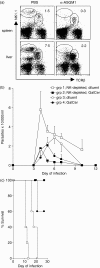During acute Trypanosoma cruzi infection highly susceptible mice deficient in natural killer cells are protected by a single alpha-galactosylceramide treatment
- PMID: 16879622
- PMCID: PMC1819570
- DOI: 10.1111/j.1365-2567.2006.02439.x
During acute Trypanosoma cruzi infection highly susceptible mice deficient in natural killer cells are protected by a single alpha-galactosylceramide treatment
Abstract
The protective immune response against Trypanosoma cruzi is improved by treatment with the natural killer (NK) T-cell glycolipid antigen alpha-galactosylceramide (alpha-GalCer). A single alpha-GalCer treatment of mice before T. cruzi infection decreases parasitaemia and prolongs survival. This protection is dependent on CD1d-restricted NKT cells and interferon-gamma (IFN-gamma) suggesting that alpha-GalCer-activated NKT cells produce IFN-gamma, which stimulates the cells of the innate and adaptive immune responses to provide protection. To learn which cells provide protection we investigate here alpha-GalCer treatment of mice deficient in different immune cells. Surprisingly, although NK cells provide protection against T. cruzi, and are a major source of IFN-gamma following alpha-GalCer treatment, NK cells are not required for the alpha-GalCer-induced protection. The alpha-GalCer treatment of NK-cell-depleted mice controlled parasitaemia and prevented death. In contrast, phagocytes, helper T cells and cytotoxic T cells are required. Furthermore, alpha-GalCer treatment of MHC II(-/-) or CD8alpha(-/-) mice exacerbated the infection, demonstrating that alpha-GalCer treatment induces some responses that favour the parasite. In summary alpha-GalCer protection against T. cruzi required multiple cellular responses, but not the response of NK cells. These results provide useful information because alpha-GalCer is being developed as therapy for infections, autoimmune diseases, allergy and cancers.
Figures



Similar articles
-
Treatment with alpha-galactosylceramide before Trypanosoma cruzi infection provides protection or induces failure to thrive.J Immunol. 2002 Jun 1;168(11):5778-85. doi: 10.4049/jimmunol.168.11.5778. J Immunol. 2002. PMID: 12023379
-
Contribution of NK, NK T, gamma delta T, and alpha beta T cells to the gamma interferon response required for liver protection against Trypanosoma cruzi.Infect Immun. 2006 Apr;74(4):2031-42. doi: 10.1128/IAI.74.4.2031-2042.2006. Infect Immun. 2006. PMID: 16552032 Free PMC article.
-
NK cell activation and protection occur independently of natural killer T cells during Trypanosoma cruzi infection.Int Immunol. 2005 May;17(5):607-13. doi: 10.1093/intimm/dxh239. Epub 2005 Mar 31. Int Immunol. 2005. PMID: 15802307
-
Innate Valpha14(+) natural killer T cells mature dendritic cells, leading to strong adaptive immunity.Immunol Rev. 2007 Dec;220:183-98. doi: 10.1111/j.1600-065X.2007.00561.x. Immunol Rev. 2007. PMID: 17979847 Review.
-
Regulation of immune responses by CD1d-restricted natural killer T cells.Immunol Res. 2004;30(2):139-53. doi: 10.1385/IR:30:2:139. Immunol Res. 2004. PMID: 15477656 Review.
Cited by
-
Inhibition of melanoma growth by subcutaneous administration of hTERTC27 viral cocktail in C57BL/6 mice.PLoS One. 2010 Sep 13;5(9):e12705. doi: 10.1371/journal.pone.0012705. PLoS One. 2010. PMID: 20856939 Free PMC article.
-
The Dialogue of the Host-Parasite Relationship: Leishmania spp. and Trypanosoma cruzi Infection.Biomed Res Int. 2015;2015:324915. doi: 10.1155/2015/324915. Epub 2015 May 18. Biomed Res Int. 2015. PMID: 26090399 Free PMC article. Review.
-
Induction of Effective Immunity against Trypanosoma cruzi.Infect Immun. 2020 Mar 23;88(4):e00908-19. doi: 10.1128/IAI.00908-19. Print 2020 Mar 23. Infect Immun. 2020. PMID: 31907197 Free PMC article.
-
Differential IFN-γ production by adult and neonatal blood CD56+ natural killer (NK) and NK-like-T cells in response to Trypanosoma cruzi and IL-15.Parasite Immunol. 2014 Jan;36(1):43-52. doi: 10.1111/pim.12077. Parasite Immunol. 2014. PMID: 24102464 Free PMC article.
-
Specific humoral immunity versus polyclonal B cell activation in Trypanosoma cruzi infection of susceptible and resistant mice.PLoS Negl Trop Dis. 2010 Jul 6;4(7):e733. doi: 10.1371/journal.pntd.0000733. PLoS Negl Trop Dis. 2010. PMID: 20625554 Free PMC article.
References
-
- World Health Organization. Control of Chagas Disease. WHO Technical Report Series, 905. Geneva: World Health Organization; 2002. pp. 1–109. - PubMed
-
- Kronenberg M. Toward an understanding of NKT cell biology: progress and paradoxes. Annu Rev Immunol. 2005;23:877–900. - PubMed
-
- Kawano T, Cui J, Koezuka Y, et al. CD1d-restricted and TCR-mediated activation of Vα14 NKT cells by glycosylceramides. Science. 1997;278:1626–9. - PubMed
Publication types
MeSH terms
Substances
Grants and funding
LinkOut - more resources
Full Text Sources
Medical
Molecular Biology Databases
Research Materials

